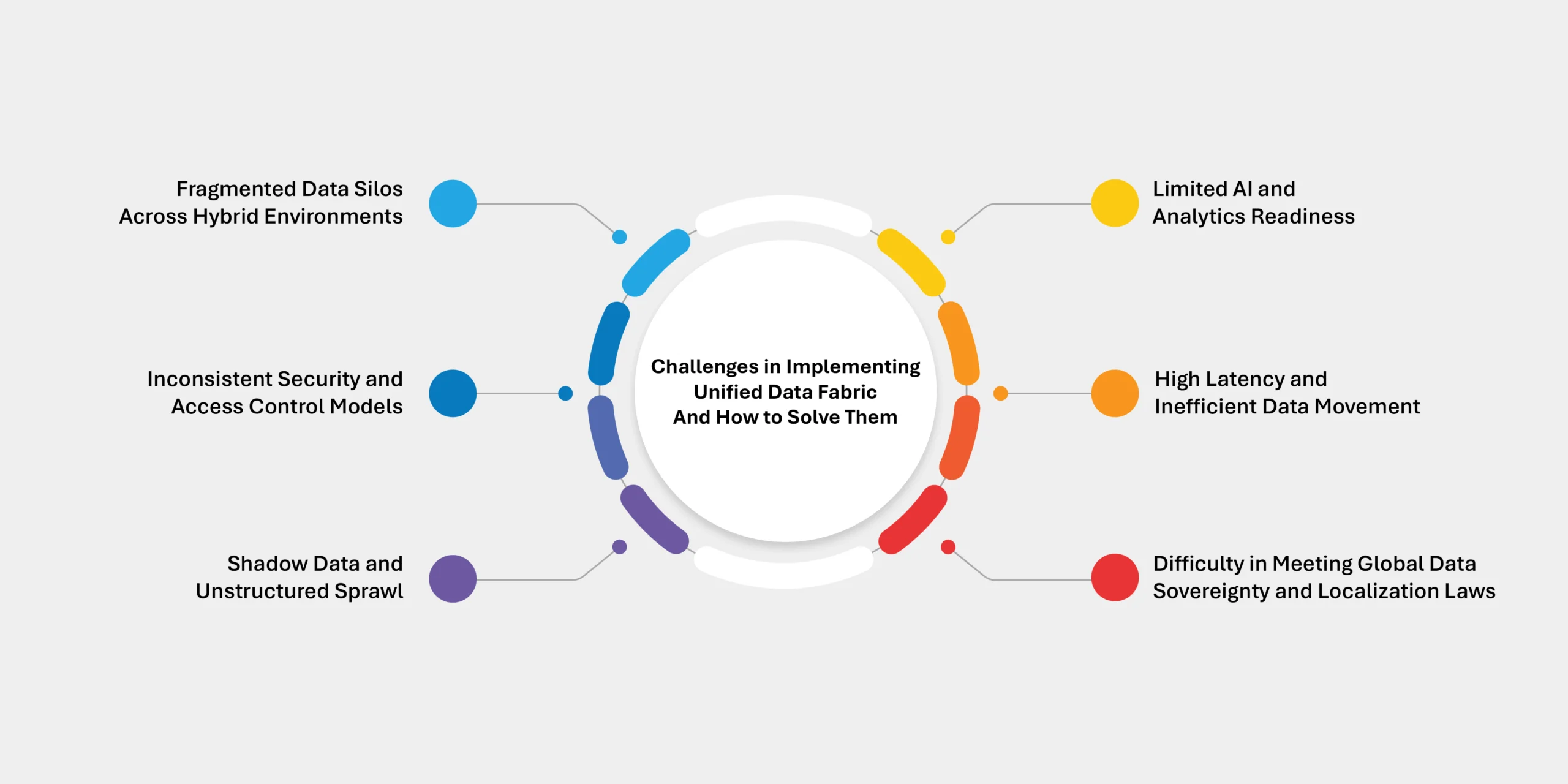What is Unified Data Fabric?
A Unified Data Fabric is an architectural framework that connects, integrates, and governs data across hybrid and multi-cloud environments—regardless of where it resides or what form it takes. It enables consistent data access, intelligent automation, security, and observability, allowing organizations to manage structured and unstructured data as a seamless, interconnected fabric.
Why It Matters: The Backbone of Modern Enterprise Intelligence
In an age where data is distributed across on-premises servers, cloud platforms, edge devices, and SaaS applications, fragmentation is the enemy of agility. Unified Data Fabric solves this by stitching disparate data sources into a single, intelligent ecosystem, turning data sprawl into a strategic advantage. It empowers enterprises to discover, catalog, secure, and optimize data in real time, all while preserving local sovereignty and global interoperability.
From supporting real-time analytics to enabling AI readiness, a unified data fabric ensures that data is accessible, trustworthy, and actionable, no matter where it lives or who needs it.
Challenges in Implementing Unified Data Fabric – And How to Solve Them

1. Fragmented Data Silos Across Hybrid Environments
Enterprises often operate in a patchwork of legacy systems, on-premises servers, public clouds, SaaS apps, and edge environments—each with its own data store, structure, and governance rules. This fragmentation hinders end-to-end visibility and creates bottlenecks in decision-making, compliance, and AI-readiness.
The Solution:
A Unified Data Fabric enables centralized metadata harvesting, cross-platform data discovery, and standardized APIs to stitch together disparate sources. With virtualized access layers and schema-on-read capabilities, it delivers a single pane of glass for all enterprise data, structured or unstructured, legacy or cloud-native.
2. Inconsistent Security and Access Control Models
Different systems use varied security protocols, identity models, and permission structures. This inconsistency not only complicates compliance but also increases the attack surface for insider threats and cyber intrusions.
The Solution:
Unified Data Fabrics integrate identity federation and zero trust access models—embedding RBAC, ABAC, and policy-as-code across environments. Context-aware access control ensures that only the right users, under the right conditions, can access sensitive or sovereign data—whether on cloud, on-prem, or edge.
3. Shadow Data and Unstructured Sprawl
Over 80% of enterprise data is unstructured and often untracked. Dark data stored in forgotten file shares, personal drives, or expired SaaS instances can hold sensitive information that remains outside governance, leading to compliance risk and storage inefficiencies.
The Solution:
A Unified Data Fabric employs AI-powered data discovery and classification to uncover hidden assets, tag PII/PHI/IP automatically, and bring unstructured data into governance. This ensures risk-aware visibility, data lifecycle control, and defensible compliance with regulations like GDPR, HIPAA, and DPDP.
4. Limited AI and Analytics Readiness
Even when data is available, it’s often incomplete, inconsistent, or lacks contextual metadata, making it unsuitable for AI model training or real-time analytics. Manual prep pipelines further delay innovation.
The Solution:
With embedded data enrichment, lineage tracking, and data quality intelligence, a Unified Data Fabric ensures data is clean, contextualized, and AI-ready by default. It reduces prep time and accelerates AI pipelines by providing governed, trustworthy data through intelligent automation.
5. High Latency and Inefficient Data Movement
Copying large volumes of data across cloud and on-prem systems leads to high latency, network congestion, and cost overruns. Redundant datasets also create unnecessary duplication and version conflicts.
The Solution:
Unified Data Fabric supports intelligent caching, policy-based tiering, and data virtualization—minimizing physical data movement while ensuring near-instantaneous access to live data. Automated lifecycle management ensures data is stored in the right location, on the right tier, at the right time.
6. Difficulty in Meeting Global Data Sovereignty and Localization Laws
As more countries enforce data localization mandates, ensuring that sensitive data resides within jurisdictional boundaries becomes both complex and critical. Missteps can lead to legal fines, reputational damage, and operational disruption.
The Solution:
Unified Data Fabrics incorporate geo-aware tagging, location-based policy enforcement, and federated governance controls. This allows enterprises to meet regional compliance mandates while still maintaining a unified global architecture for analytics and collaboration.
Strategic Catalyst: Unifying Data for AI, Sovereignty, and Zero Trust
A Unified Data Fabric is no longer just a back-end integration layer—it’s the foundation for AI-driven innovation, regulatory compliance, and secure enterprise architecture in a distributed world. As organizations scale across hybrid clouds, edge environments, and global markets, the need for unified control and visibility over data becomes mission-critical.
AI-Driven Intelligence
A Unified Data Fabric enables seamless integration of data across silos—structured and unstructured, cloud and on-prem. By harmonizing metadata, enforcing data quality standards, and integrating directly with ML pipelines, it empowers AI systems to draw insights from trusted, contextualized data. The result? Better predictions, faster model iteration, and reduced risk of bias or hallucination.
Federated Sovereignty and Policy Enforcement
In an era where data must adhere to borders, a Unified Data Fabric enables enterprises to meet localization requirements without compromising operational flexibility. Geo-tagged data visibility, regional policy enforcement, and decentralized access control enable compliance with GDPR, DPDP, HIPAA, and emerging sovereignty frameworks, while maintaining global-scale operations.
Zero Trust by Design
Security is no longer about perimeter defense—it’s about enforcing control wherever data lives or moves. A Unified Data Fabric embeds policy-as-code, identity-aware access, and real-time lineage tracking into every data transaction. Whether a dataset is accessed from an AI app in the cloud or a remote edge device, permissions and context are validated before action, making Zero Trust a functional reality.
The Future of Data Fabrics: Autonomous, Policy-Driven, Intelligent
Next-gen data fabrics will go beyond orchestration—they will become autonomous ecosystems. AI will drive data discovery, classification, and movement; policies will adapt in real time based on usage, compliance, or threat signals; and data observability will offer proactive insights into data drift, risk exposure, or compliance violations.
In this future, enterprises won’t need to search for data—data will find them, with full context, control, and clarity.
Getting Started with Data Dynamics:
- Learn about Unstructured Data Management
- Schedule a demo with our team
- Read the latest Blog: The Real AI Bottleneck Isn’t Compute—It’s Trustworthy Data






